And they’ve already started to see significant success.
The Doyle Drive Franciscan manzanita, as the plant uncovered in 2009 is referred to, was moved about a mile away from the construction site, to an undisclosed location in the Presidio, to protect it from thieves and curious onlookers.
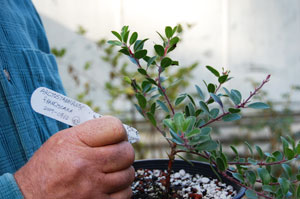 Don Mahoney holds one of the nearly 170 Franciscan manzanitas that the San Francisco Botanical Garden has grown from the one found in 2009.During the move, some branches were trimmed off so it would fit on a crane, said Mahoney. The cuttings were divided among six institutions: the San Francisco Botanical Garden; the University of California Botanical Garden at Berkeley; the Regional Parks Botanic Garden in Berkeley’s Tilden Park; the Arboretum at the University of California, Santa Cruz; the Presidio’s own native plants nursery and Cal Flora, a commercial nursery in Sonoma County specializing in manzanitas.
Don Mahoney holds one of the nearly 170 Franciscan manzanitas that the San Francisco Botanical Garden has grown from the one found in 2009.During the move, some branches were trimmed off so it would fit on a crane, said Mahoney. The cuttings were divided among six institutions: the San Francisco Botanical Garden; the University of California Botanical Garden at Berkeley; the Regional Parks Botanic Garden in Berkeley’s Tilden Park; the Arboretum at the University of California, Santa Cruz; the Presidio’s own native plants nursery and Cal Flora, a commercial nursery in Sonoma County specializing in manzanitas.
Together they have grown 424 plants genetically identical to the one found in the Doyle Drive construction site, said Betty Young, director of nurseries for the Golden Gate National Parks Conservancy, who is coordinating the effort.
Close to 170 of these young plants live in pots in a sunny area of the San Francisco Botanical Garden’s nursery, and now have roots and tiny flower buds that will bloom in the spring. From the one have come many, and with them, hope for restoring some of the Bay Area’s original wild character.
“Each one is ready to be a 14-foot across plant,” said Mahoney, “if we can just find enough spots in San Francisco to plant them all.”
The ultimate goal is to establish populations of the Franciscan manzanita in the wild. To do so, experts must first find places where the plant is likely to thrive. The challenge is to find open spaces with the type of rocks where Franciscan manzanita likes to grow.
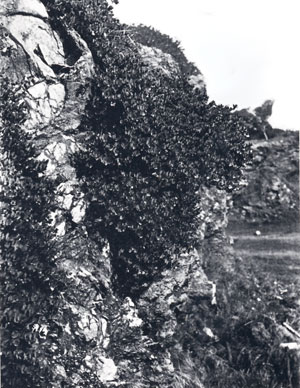 A Franciscan manzanita cascades over a bluff at San Francisco’s Laurel Hill cemetery in 1938. Courtesy of Alice Q. Howard.The plant grew on serpentinite and green stone rock, which occur commonly in earthquake zones. San Francisco is crisscrossed by these rocks, said Michael Chassé, a geography graduate student at San Francisco State University and a natural resources management specialist at the Golden Gate National Recreation Area, who is writing his thesis on the Franciscan manzanita. Places like the former Mint building at the top of Market Street, are believed to have had Franciscan manzanita growing on serpentinite, he said.
A Franciscan manzanita cascades over a bluff at San Francisco’s Laurel Hill cemetery in 1938. Courtesy of Alice Q. Howard.The plant grew on serpentinite and green stone rock, which occur commonly in earthquake zones. San Francisco is crisscrossed by these rocks, said Michael Chassé, a geography graduate student at San Francisco State University and a natural resources management specialist at the Golden Gate National Recreation Area, who is writing his thesis on the Franciscan manzanita. Places like the former Mint building at the top of Market Street, are believed to have had Franciscan manzanita growing on serpentinite, he said.
Most such rocky formations now have buildings on top of them – this loss of habitat is what led the Franciscan to extinction in the early 1940s. Chassé is looking for patches of open space at least one acre in size where the rocks are still present.
He has identified and started to visit about 10 possible San Francisco locations in the Presidio, Mt. Davidson, McLaren Park, Twin Peaks and the Starr King Openspace. The sites are, for the most part, protected either by San Francisco Recreation and Parks or the National Park Service.
But open space alone isn’t enough to create a healthy population of Franciscan manzanitas, said Chassé.
“When you think about reintroducing a plant, you want the widest genetic diversity,” he said. “You don’t want to just plant individuals from one plant.”
When plants are able to cross-pollinate with plants that are of their same species but have a different genetic makeup, they’re more likely to produce seeds that will allow the plants to reproduce spontaneously.
All 424 Franciscan plants grown by the botanical gardens come from the one found near Doyle Drive by Gluesenkamp, director of habitat protection and restoration for Audubon Canyon Ranch, in Marin County. This means that the plants are like genetically identical siblings of each other.
As it turns out, though, suitable mates are available. These are plants that botanists saved in the 1930s before the Franciscan manzanita disappeared in the wild.
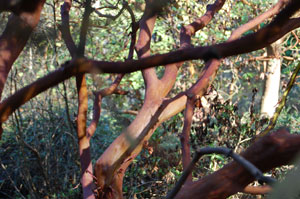 Manzanitas are recognizable by their reddish bark.The last known location where Franciscan grew was San Francisco’s old Laurel Hill cemetery, where the city’s Laurel Heights neighborhood now stands. The land where San Francisco’s cemeteries operated became so valuable that in the 1930s the city passed an ordinance to prevent burials, with the intention of closing them down, said Chassé. By 1940, Laurel Hill cemetery had been bulldozed and the last of the wild Franciscan was gone.
Manzanitas are recognizable by their reddish bark.The last known location where Franciscan grew was San Francisco’s old Laurel Hill cemetery, where the city’s Laurel Heights neighborhood now stands. The land where San Francisco’s cemeteries operated became so valuable that in the 1930s the city passed an ordinance to prevent burials, with the intention of closing them down, said Chassé. By 1940, Laurel Hill cemetery had been bulldozed and the last of the wild Franciscan was gone.
But botanists had collected samples and planted them in local botanical gardens like the Regional Parks Botanic Garden in Berkeley’s Tilden Park. Franciscan manzanitas were also planted at the San Francisco Botanical Garden, the University of California Botanical Garden in Berkeley and others, where they can be seen in their collections today.
Chassé said he doesn’t know how many Franciscan plants with different genetic makeups exist in these gardens. Genetic testing – which is complicated, expensive and time-consuming – hasn’t been conducted. So he is visiting botanical gardens, talking to curators like Mahoney and combing documents to try to figure it out.
“Are there 20, or two or three?” he said. “The records are unclear.”
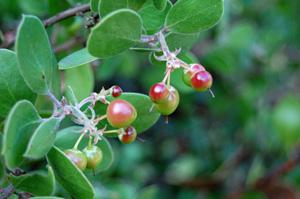 Manzanita berries are called bear berries because bears like them. People can eat them too. They’re sour.Distinctive for their reddish bark and white and pink bell-shaped flowers, botanists consider manzanitas to be California’s iconic plant. Some 50 species are distributed throughout the state, each adapted to a particular ecosystem, from the coast to the High Sierra, said Mahoney. The Franciscan is one of two manzanita species that grew only in San Francisco, thriving in its foggy climate.
Manzanita berries are called bear berries because bears like them. People can eat them too. They’re sour.Distinctive for their reddish bark and white and pink bell-shaped flowers, botanists consider manzanitas to be California’s iconic plant. Some 50 species are distributed throughout the state, each adapted to a particular ecosystem, from the coast to the High Sierra, said Mahoney. The Franciscan is one of two manzanita species that grew only in San Francisco, thriving in its foggy climate.
In Spanish, manzanita means “little apple.” The plant’s tiny, apple-shaped fruit are edible, and Native-Americans used them as a staple in the winter and spring, said Mahoney. But as buildings spread across San Francisco’s landscape, the city’s two unique species of manzanitas were destroyed.
Today, the difficulties of reestablishing a population of rare plants in the wild is illustrated by the story of the other manzanita found exclusively in San Francisco. The Raven’s manzanita, a low-lying shrub like the Franciscan, was also believed to have gone extinct in the wild until it was rediscovered in 1952, also in the Presidio.
Just like the Franciscan, a single plant of Raven’s manzanita exists in the wild, in an undisclosed location in the Presidio. But unlike the Franciscan, no other specimens of Raven’s manzanita were salvaged. So it has been near impossible for botanists to get the plant to produce seed from which a plant will grow.
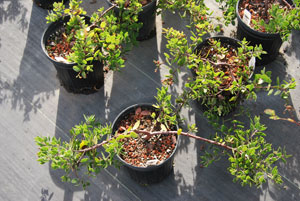 The Raven’s manzanita faces a harder time than the Franciscan manzanita. Only one individual exists.The University of California Botanical Garden at Berkeley has had some success, said curator Holly Forbes. It is the only botanical garden that has produced seeds from the Raven’s manzanita. But in order to get the seeds to actually germinate and grow into a plant, a volunteer at the garden had to try 32 different methods, said Forbes. (The two methods that worked involved either refrigerating them, or soaking the seeds in liquid smoke, an infusion produced from smoke passed through water.) The garden has since managed to get 15 Raven’s manzanitas to grow from seed.
The Raven’s manzanita faces a harder time than the Franciscan manzanita. Only one individual exists.The University of California Botanical Garden at Berkeley has had some success, said curator Holly Forbes. It is the only botanical garden that has produced seeds from the Raven’s manzanita. But in order to get the seeds to actually germinate and grow into a plant, a volunteer at the garden had to try 32 different methods, said Forbes. (The two methods that worked involved either refrigerating them, or soaking the seeds in liquid smoke, an infusion produced from smoke passed through water.) The garden has since managed to get 15 Raven’s manzanitas to grow from seed.
“Our goal was to get new genes that might give it an advantage for surviving in the wild,” said Forbes. Even though the seeds came from plants that are genetically identical to each other, some genetic recombination does happen during the process.
With more genetic material to work with, botanists expect the Franciscan manzanita to have an easier time than its relative, and are excited at the prospect of trying to recreate part of San Francisco’s native landscape.
“I look at remaining natural habitats as the original skin of the Earth. And there’s very little of that left in San Francisco,” said Mahoney. “And to actually find one of the anchor and key plants that originally existed in San Francisco and to be able to save it meant a lot to anybody who works with plants and the environment.”
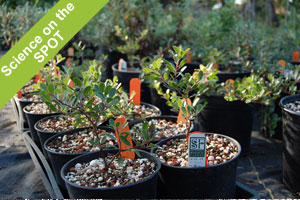 Young plants of the Arctostaphylos franciscana, or Franciscan manzanita, once thought to be extinct in the wild.In October 2009, a botanist on his way home from work spotted a low-lying, 18-foot-long shrub at a construction site near the Golden Gate Bridge. The plant, a Franciscan manzanita, was a miracle of survival – a species thought to have been extinct in the wild for almost 70 years.
Young plants of the Arctostaphylos franciscana, or Franciscan manzanita, once thought to be extinct in the wild.In October 2009, a botanist on his way home from work spotted a low-lying, 18-foot-long shrub at a construction site near the Golden Gate Bridge. The plant, a Franciscan manzanita, was a miracle of survival – a species thought to have been extinct in the wild for almost 70 years.
 Don Mahoney holds one of the nearly 170 Franciscan manzanitas that the San Francisco Botanical Garden has grown from the one found in 2009.
Don Mahoney holds one of the nearly 170 Franciscan manzanitas that the San Francisco Botanical Garden has grown from the one found in 2009. A Franciscan manzanita cascades over a bluff at San Francisco’s Laurel Hill cemetery in 1938. Courtesy of Alice Q. Howard.
A Franciscan manzanita cascades over a bluff at San Francisco’s Laurel Hill cemetery in 1938. Courtesy of Alice Q. Howard. Manzanitas are recognizable by their reddish bark.
Manzanitas are recognizable by their reddish bark. Manzanita berries are called bear berries because bears like them. People can eat them too. They’re sour.
Manzanita berries are called bear berries because bears like them. People can eat them too. They’re sour. The Raven’s manzanita faces a harder time than the Franciscan manzanita. Only one individual exists.
The Raven’s manzanita faces a harder time than the Franciscan manzanita. Only one individual exists.